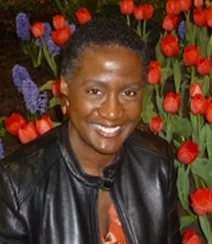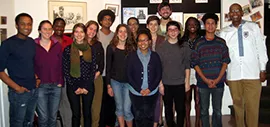Collaboration Gives Voice to Civil Rights Movement at Swarthmore

The archive "stands as a bulwark against the College losing or forgetting the story of black student activism, which significantly improved Swarthmore for the better,” says Allison Dorsey, professor of history, who designed and managed the extraordinarily collaborative effort.
A team of faculty, staff, students, and alumni has created a digital archive on the civil rights movement at Swarthmore, reframing the narrative through the lens of the era’s key figures.
The product of a special research seminar, Black Liberation 1969, the archive fuels the College’s celebration of its sesquicentennial and Black History Month. This resource takes the College community of today and tomorrow back in time to see and feel the tumult and transformation of the late 1960s.
“More importantly, it stands as a bulwark against the College losing or forgetting the story of black student activism, which significantly improved Swarthmore for the better,” says Professor of History Allison Dorsey, who designed and managed the extraordinarily collaborative effort.
The team consisted of Nabil Kashyap, librarian for digital initiatives and scholarship, Alison Roseberry-Polier ’14, Maria Mejia ’15, and John Gagnon ’17. They and Dorsey spent most of the summer developing the site, but only after considering some difficult questions.
“What was the College comfortable with airing and making transparent?” says Kashyap, noting the reach of an online archive. “I think there was a moment of soul-searching and engaging with new research environments on the part of the institution.”
The team collected nearly 1,000 documents. Among these sources were materials from past presidents, deans, and committees of the College; the Cygnet, The Halcyon, and The Phoenix; the Swarthmore Afro-American Student Society; local and national media; social service and political organizations; and the Federal Bureau of Investigation, which spied on student groups here in the late 1960s.
This array of voices and viewpoints brought what could have just been a basic repository alive, says Kashyap.
“These very different views of the College, sometimes contradictory or even hostile to one another, all sharing the same space," he says, "that’s what makes the archive kind of thrilling.”
The archive also features interviews with black alumni, two professors emeritus, and a long-time community activist. Their reflections are the first of their kind, notes Dorsey, giving a voice to those who led the 1969 takeover of Parrish Hall to fight for more black students to be enrolled.
“The most memorable aspect of this project was getting to talk to activists who had actually organized and participated in these protests,” says Mejia, a history major from Bronx, N.Y., who conducted one interview in Washington, D.C., and another on Skype. “I was amazed that their memories were so vivid, even 45 years later.”
The archive was designed to educate the Black Liberation 1969 students and the College community at large about not just the struggles but the successes of the movement here, including the hiring of black faculty and administrators, the development of a Black Studies program, and the creation of the Black Cultural Center.
“This project makes it impossible to ignore the incredible role black student activists had in transforming Swarthmore’s curriculum and campus culture,” says Roseberry-Polier. “At the heart of this history is a group of black students pushing to make Swarthmore relevant to its students, meaningfully inclusive, and true to its own values.”
Since the obligation to uphold institutional values never ends, the archive contains a lesson for current and future students.
“This was not an instance of a group demonstrating against inequality, it was an extreme commitment to a goal,” says Gagnon, of Clarkesville, Ga. “It took continual effort and planning as well as discipline. Their example is an excellent example of true, determined activism.”
Dorsey credits the support of College administration and alumni and vital funding from the Sesquicentennial Committee for helping her to fulfill her vision for the project, which began percolating soon after she came to Swarthmore in 1997. She also lauds the research team’s efforts in navigating a web of logistical concerns.
The project was a “rather complicated dance,” she says, “requiring brainstorming, touching base, checking in about the big questions and the small details” in order to flip the switch on the archive in time for Black History Month.
Dorsey and Kashyap debuted the resource to an overflow crowd in Kohlberg Hall’s Scheuer Room last week, intriguing, entertaining, and drawing insightful commentary from all areas of the College community. Dorsey even received a standing ovation from the students taking part in the project — an expression of well-earned admiration that goes both ways.
“While this was the most exhaustive, labor-intensive, time-consuming project I've ever worked on,” says Dorsey, “the reward was watching the students commit to the project, struggle with deadlines and expectations, and sometimes even surprise themselves with their success. I'm not sure teaching ever gets any better than this.”
Swarthmore’s Black Liberation 1969 Black History Month events continue Thursday with the lecture 1969: The Revolutionary Spring of Black Students. Other highlights include a presentation of students' research February 10, the exhibit Proof of Black Life: The Photography of Leandre Jackson '75 being displayed in McCabe Library beginning February 17, and the lecture Black Students and the Transformation of Higher Education on February 26. The artwork of Black Liberation 1969 students will also be on display at various campus locations throughout the month.




